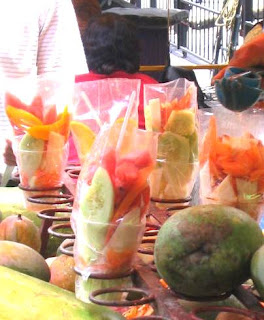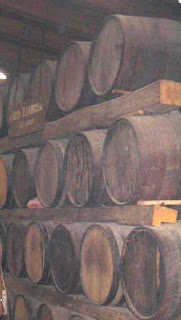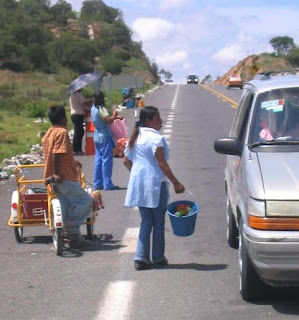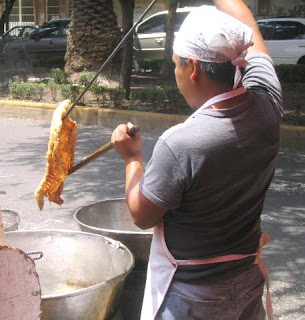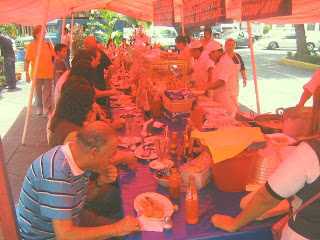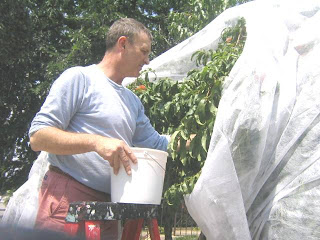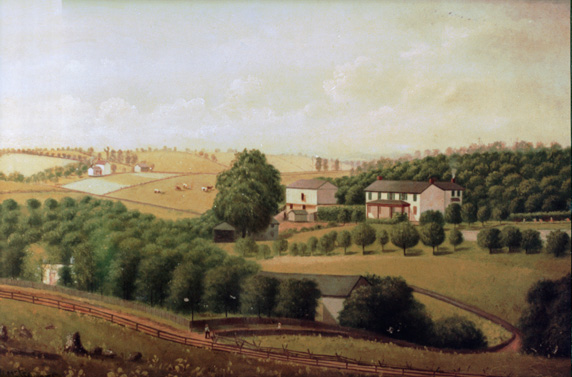
Our friend Tom has introduced us to breakfast at the
Mayordomo restaurant here in Oaxaca as one of the best bargains going. Seventy pesos, or a bit less that $7 US buys all you can eat at a buffet that opens for business at 8 am. Along with fresh fruits, ranging from
cantaloupe to pineapple and papaya, there´s a selection of dry cereals, yogurt, pancakes, French toast, bacon, enchiladas of some sort, often
pozole,
quesadillas,
Oxacan cheese with
poblanos, omelets to order and small tortillas smothered in black beans and fresh cheese called
memolitos.
At
Mayordomo we were also introduced to a
Oaxacan pizza called a
tlayuda, which is actually a huge tortilla dressed with beans, cheese, lettuce, sausage or whatever your preferred toppings may be. A great late-night snack and dinner here often takes place late at night, since lunch often is not taken before two or three in the afternoon.

Tom´s wife,
Ninfa, has always been extremely protective of us on our visits to Mexico. Meaning, she steers us away from our most natural inclinations, which are to find our food on the streets.
Ninfa and Tom make sure that we, and especially our daughter, are not exposed to the local water, even insisting on purified water in the ice in our soft drinks. So we have been chaffing somewhat here in Oaxaca, long viewed as a culinary center of the country, and being confined to restaurants where our tendencies to eat anything and everything are restrained.
In the markets we have seen the legendary grasshoppers and grubs for sale. And finally one evening recently we found ourselves in a restaurant who´s name translates approximately as Grandma´s Place. And there I tasted my first grasshoppers as an appetizer. The
didn´t look so much like bugs as dark, ground up meal. Bu

t salty, and thirst invoking when spread on a tortilla with the guacamole provided. But having hoofed around the city for several days we are constantly exposed to the little ladies patting out their tortillas and frying them on their propane-heated grills or
comals, filling them to order with the local cheese and beans and seasonal squash blossoms.
In some parts of town, the streets are lined with temporary
fondas or food stalls where tables are covered with plastic liners, the diners seated in plastic chairs and the street covered with blue plastic tarpaulins to protect against the rains that fall inevitably in the afternoons this time of year.

On particular market, the Mercado 30
Novembre, is devoted almost exclusively to more permanent version of the
fonda. As elsewhere in the country, these are typically long diner-style
counter tops clad in white tile with stools spaced in front for the diners. One or two or sometimes a whole contingent of female cooks and staff will stand behind the counter waiting for an order. Although unlike most
fondas I have visite

d, there seems to be a rather intense competition for customers. Approach one of the stalls and you will be accosted with the day´s menu and the specialties of that particular
fonda. Even as you eat, there is a crush of vendors pressing up behind you offering all manner of toys and trinkets and cheap jewelry for sale.
We finally convinced Tom and
Ninfa that they would not hear the last of it if we did not visit one of the
fondas at least once for one of our meals. So we trekked down to the Mercado 30
Novembre and somehow found the entrance where the meat grilling takes place. It would be a mistake to imagine that anything other than grilling meat takes place in thi
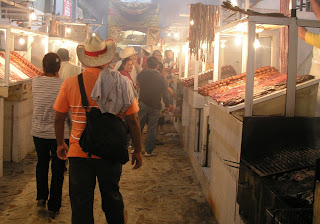
s particular hall of the market. Each stall has its slabs of skirt steak and other cuts hanging for inspection. Between the stalls, along both walls, are charcoal fires burning and attendants fanning them furiously, almost in unison. Rising about the scene is a thick cloud of smoke, that resides permanently on the ceiling in the form of a gigantic stain of grease and creosote. Simply passing through the hall was so intensely hot that we felt we were running a gauntlet.
Deeper into the market we found our place, or a
fonda for five. The menu is simple: tortillas,
quesadillas, tamales, beans, rice, soup. There are votes for some of each. I am anxious to try the
Oaxacan tamale with black mole, wrapped in a banana leaf.
Fonda food is home cooking, rustic and rough around the edges. No garnishes, bells or whistles. The soup, for instance, is a meal in itself, with whole green beans, big chunks of carrot and cabbage, a generous morsel of chicken breast meat. We receive cutlery, but often there is v

ery little need. A plate of tortillas and any Mexican is set. We watch one gentleman in a straw caballero hat rip a tortillas in pieces.
With a swatch in each hand, he pushes the food onto a piece of tortilla and into his mouth it goes. Occasionally he picks up his fork, but it is only to push some beans and rice onto his tortilla.
My
tamale is everything I hoped for. Unlike a restaurant version I´d been served the night before, dry and bland, this one is fresh and tender. The mole is dark, slightly
spicy and
chocolaty. Inside is a piece of chicken, bones and all. We feel the
fonda is where we belong....
(Photo, top, by Tom Janota)
 Thanks to the Ethicurian, I´ve added a new feature to The Slow Cook: an interactive map to the biggest polluting factory farms in the nation, provided by the environmental group Food and Water Watch.
Thanks to the Ethicurian, I´ve added a new feature to The Slow Cook: an interactive map to the biggest polluting factory farms in the nation, provided by the environmental group Food and Water Watch.


